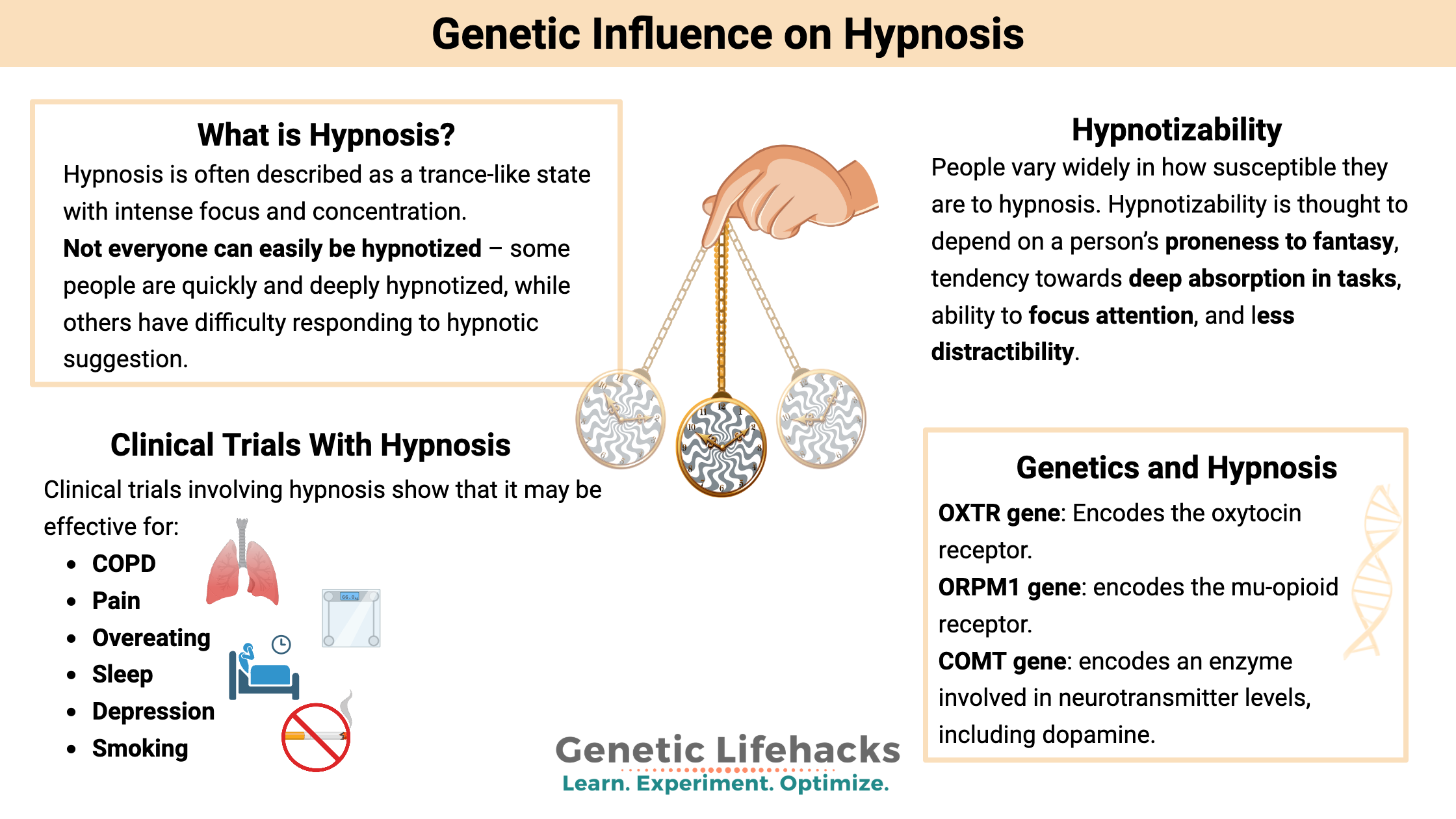Key takeaways:
~ Hypnosis is a state involving deep relaxation and intense focus.
~ Research shows hypnosis is associated with changes in brain activity, such as deactivation of the frontal cortex and increased activity in regions like the inferior frontal gyrus in highly hypnotizable individuals.
~ Neurotransmitters like oxytocin and dopamine are involved in the hypnotic response, and genetic variants affect the responsiveness to hypnosis.
~ Certain gene variants in the oxytocin receptor gene (OXTR) and the mu-opioid receptor gene (OPRM1) have been shown to influence hypnosis susceptibility.
What happens when you’re hypnotized?
Hypnosis is often described as a trance-like state with intense focus and concentration. While hypnotism may bring to mind stage tricks, like clucking like a chicken, hypnosis is increasingly being recognized for its clinical benefits, such as for pain management and lifestyle changes.
However, not everyone can easily be hypnotized – some people are quickly and deeply hypnotized, while others have difficulty responding to hypnotic suggestion.
Interestingly, studies show that hypnotizability – how easily someone can be hypnotized – is fairly stable throughout life. If you aren’t easily hypnotized as a young adult, then you are also likely not to respond to hypnosis in middle age. However, time of day does seem to influence hypnotizability a bit, with people being more responsive to hypnosis in the morning compared to the afternoon.[ref][ref]
Hypnotherapy typically involves four stages:[ref]
- Induction: This is when the therapist helps you relax and focus.
- Deepening: When you increase your focus and relaxation.
- Suggestions: This is when the hypnotherapist uses carefully chosen language to propose a change in behavior or reaction, such as stopping smoking.
- Emergence: Coming out of hypnosis slowly, usually with help from the therapist.
What happens in the brain with hypnosis:
Brain imaging studies can give us an idea of what occurs in the brain during hypnosis.
The fMRI test shows changes in blood flow in active areas of the brain. A fMRI study involving adults who were moderately susceptible to hypnosis compared the hypnotized state to the resting state brain images. The results showed that hypnotism (without targeting) was associated with the disassociation of the frontal cortex. Another study showed increased activation in the inferior frontal gyrus for highly hypnotizable people. [ref][ref]
EEG studies often categorize individuals based on their tendency toward high or low dissociative states during hypnosis. A 2025 study showed that those with high or low disassociative states under hypnosis had different brain wave patterns both before and after hypnosis. Differences were shown for the power of delta, theta, alpha, beta, and gamma bands.[ref]
Hypnotizability:
People vary widely in how susceptible they are to hypnosis. Researchers classify subjects as having high, medium, or low hypnotizability. About 70% of people fall into the medium category, with 15% being either high or low.[ref]
Hypnotizability is thought to depend, at least in part, on a person’s proneness to fantasy, tendency towards deep absorption in tasks, ability to focus attention on an internal or external object, and less distractibility.[ref]
Essentially, hypnotizability comes down to differences in:
- Attention and executive control in different brain regions[ref]
- The ability to be deeply absorbed in tasks, such as reading.
- The tendency towards fantasizing or disconnecting from thoughts and feelings.
Neurotransmitters and neuropeptides involved in hypnosis:
During hypnotic sessions, oxytocin – a hormone linked to bonding and social trust – is released both in the hypnotist and in the person being hypnotized. Trust between the person being hypnotized and the therapist is important.
One study showed that administering oxytocin nasal spray before hypnosis increased the compliance of the hypnotized individual.[ref]
People who are more highly hypnotizable typically have faster reaction times during complex decision making, as well as shorter latency for auditory, visual, and somatic sensing. Dopamine response in certain regions of the brain is thought to be involved in the neurological differences in people who are more easily hypnotized.[ref]
Clinical trials involving hypnosis:
Access this content:
An active subscription is required to access this content.

